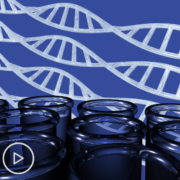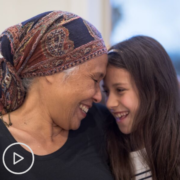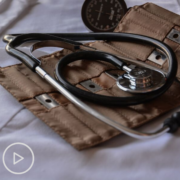How do you decipher what’s fact and what’s fiction when it comes to Acute Myeloid Leukemia (AML) research and “miracle cures” you may encounter online? Attend this webinar, as Dr. Sangmin Lee shares updates in research and debunks common rumors that are passed around related to treating and “curing” AML. Download the accompanying Fact or Fiction? AML Resource Guide.
Dr. Sangmin Lee is a hematologist-oncologist specializing in blood disorders and blood cancers at Weill Cornell Medicine and New York Presbyterian Hospital.
See More From The Fact or Fiction? AML Series
Related Resources
Transcript:
Patricia:
Welcome to “Fact or Fiction: AML Research and Bogus Online Cures.” Today, we’re talking about acute myeloid leukemia. We’ll debunk common misconceptions about AML, research, and focus online information.
I’m Patricia Murphy, your host for today. Joining us is Dr. Sangmin Lee. Dr. Lee, take a moment. Introduce yourself.
Dr. Lee:
So, my name is Sangmin Lee. I’m at Weill Cornell Medicine in New York City, and New York Presbyterian Hospital. And I’m an attending in the leukemia program here, so I focus on leukemia treatment and clinical trials with leukemia.
Patricia:
Great. Thanks so much for joining us. Before we get started, just a reminder, this program is not a substitute for medical advice. So, please, consult your care team when you have questions.
Dr. Lee, thanks so much for joining us, again. Can you please give us an overview of the field of AML research?
Dr. Lee:
So, AML research is evolving very rapidly, and there’s a lot of promising new drugs that have come out in AML. As with any other cancers, we’re getting more sophisticated in characterizing AML in terms of molecular mutations, and characterizing AML stem cells, so –
The field is moving very rapidly in that regard. There have been a number of promising and effective drugs that have been approved in the last few years, as well. For example, Venetoclax has been a game changer in treatment of AML, especially in the elderly population. And there are several targeted agents that have been FDA approved in the recent years, as well. So, definitely since about three to five years ago, there have been new drugs that have come out for AML that is very exciting for treatment of AML.
Patricia:
Let’s talk a little bit about genetic testing. How is that changing the landscape for AML patients?
Dr. Lee:
So, genetic testing has become standard in AML patients, in terms of – at their diagnosis and relapse. And part of that is, we can use that information to guide prognosis, how well or not well a patient is expected to do.
But more importantly, there are actually drugs that can target specific mutations. For example, there are new drugs that target a mutation called IDH1 and 2 that have been approved recently for patients with AML, as well as new drugs that target mutation called FLT-3, or FLT3 mutation, as well. So, genetic testing has become standard, not only to tell you prognostic information, but also used in therapy for AML patients.
Patricia:
You mentioned a few treatments that were advancing. What other therapies are showing promise for AML?
Dr. Lee:
So, there are a number of treatments that are ongoing. Venetoclax has been game-changing, and now, although Venetoclax has improved outlook, in terms of AML treatment, compared to conventional therapy, there’s still resistance to Venetoclax and the response is not durable.
So, there is research looking at resistance mechanisms to Venetoclax, for example. The other exciting field is, there are some advances in chemotherapy, with clinical trials underway. Like in other malignancies, there are clinical trials involving CAR T-cell, or other ways of engaging your own T cell immune system to approach and attack the AML.
Patricia:
Great segue to clinical trials. What is the process for getting medicine to patients during clinical trials?
Dr. Lee:
So, clinical trials are basically what’s needed to prove that drugs work. So, a lot of times, we test drugs in a test tube in AML cell lines, and they show great promise. But just because a drug works in a test tube setting, doesn’t actually mean that it will work in humans, because human bodies are much more complicated. So, we need to test promising drugs in humans to make sure they are safe and effective.
And that’s what the purpose of clinical trials are. Once they demonstrate safety and efficacy, then a drug then gets to be approved, and is available commercially. So, that’s the purpose of clinical trials.
To be involved in clinical trials, what it involves is, basically, you have to meet a sort of criteria, called eligibility, because different clinical trials have different criteria for selection. So, we have to look into that. And then, once you fit an eligibility or selection criteria, then you typically undergo certain diagnostic tests to enroll on a clinical study. And then, you get whatever drug or intervention that is going to test in that setting.
So, there are numerous steps to actually enroll in a clinical study.
Patricia:
And like you mentioned, there’s a long way between rat studies and human trials. What are the phases of clinical trials?
Dr. Lee:
So, there are three phases for clinical trials, commonly. There’s phase one, and phase two, and phase three. Phase one is the earliest part of the clinical trial process. So, goal of a phase one study is to make sure a drug is safe in a human. So, phase one studies are usually the first time that you are testing the drug in humans, and the main purpose is to demonstrate that it’s safe. So, typically, in a phase one study, typically, you test a drug at a lower dose or dose levels to demonstrate safety. What it means is that you’re enrolling a few patients at a time.
Once a drug is proven to be safe, then you will want to phase two, which is basically testing the drug in more patients. And the purpose of phase two is to get a preliminary assessment of how effective a treatment would be.
So, typically, a phase two study involves many more patients in that setting. And then, if a phase two study shows that a drug is very promising, then the drug may move on to phase three, where, basically, in phrase three, you are comparing one intervention or a drug compared to the standard of care. And, typically, in a phase three setting, a computer decides randomly which intervention you get, whether it’s an intervention or new drug versus standard of care. And standard of care may include either placebo or chemotherapy intervention, that is standard of care. So, it’s not always placebo in phase three.
Patricia:
Sure, sure. Okay, we’ll play a little game, now. I’ll tell you a few things that we’ve heard from AML patients, and you tell me if this is fact or fiction. Okay, Dr. Lee?
Dr. Lee:
Yeah.
Patricia:
Clinical trials are the last resort treatment option.
Dr. Lee:
That’s actually not true in a lot of cases, because, yes, there are a lot of clinical trials after you have tried all of the standard therapy. But then, standard therapy in AML, like any other condition, are not perfect. So, there are many clinical trials where, even if you’re diagnosed with new AML, because standard care is not perfect, there are trials to try to improve upon the standard of care.
So, there may be clinical trials when you’re first diagnosed with AML, as well.
Patricia:
Yeah. How about this one: I feel like a guinea pig.
Dr. Lee:
Well, the clinical trial is to test drugs in humans. So, in a way, you are a test subject. But then, you have to remember that all of the drugs that we are testing have a rationale.
They all show promise, in terms of laboratory testing to kill leukemia cells in the test tube. And the problem is that, just because they are killed leukemia cells in the test tube, or in an animal model, doesn’t actually mean that it works in humans, or we know the safety profile. So, we need to do these testings to demonstrate that these drugs, which seem promising, actually work in humans.
Patricia:
Right. Well, then, that’s a good segue to this thing we’ve heard: Treatments being studied today may be the future standard of care.
Dr. Lee:
That is absolutely true, because all of the new developments that have come out, including Venetoclax, or IDH inhibitors, or other inhibitors, that are approved today, came through the clinical trial process. One example I like to include is a patient of mine, who, five years ago, had very, very aggressive leukemia, and she happened to have an IDH2 mutation.
It was four or five years ago. And she has a very refractory, aggressive leukemia, and it was life-threatening. And she had an IDH2 mutation. And we enrolled her in a clinical trial involving ivosidenib, which was in clinical trial at the time.
Ever since then, she became – she went into remission, and she has a normal blood count. And, to this day, she’s on this medicine, which is now approved, and she remains healthy with a normal blood count, in remission. So, yes. Clinical trials do include promising drugs, and if they show really good efficacy and promise, they will become standard of care down the road.
The advantage of clinical trial is that you may get early access to drugs that may become standard care down the road. So, it’s a way to get early access to potentially promising drugs.
Patricia:
How do you counsel your patients about joining clinical trials? What are you thinking about when you’re talking with them?
Dr. Lee:
So, in terms of clinical trials, we all look at clinical trials, and they exist for a reason, because we think that an intervention or drug can do better than standard of care. So, how I approach it is that, depending on the situation, if we can improve upon what is available, or if there are no other options, then it definitely is a great option to improve upon what would otherwise be standard.
Patricia:
Sure. All right, how about this one: I may have unexpected costs if I join a clinical trial.
Dr. Lee:
So, typically, that’s actually, usually not true, because how it works is that the clinical trial drugs, and that there may be extra procedures or visits associated with clinical trials.
And what usually happens is that the sponsor of the clinical trial provides the cost of the drug, intervention, and anything extra that are required for the clinical trial. So, in the end, the cost of participating in a clinical trial should not be any more than receiving standard care treatment.
In some rare cases, there may be stipends associated with the clinical trial, especially with travel. So, if you participate in a clinical trial, and you live far away, then you should ask to see if there is any stipends available, especially for travel.
Patricia:
Okay. How about this next one? I am monitored more closely in a clinical trial.
Dr. Lee:
In some cases, it’s true. Clinical trials do have certain monitoring visits, in terms of doctor’s visits, laboratory tests, and physical exams.
The purpose of that is to make sure that it is safe. So, the purpose of monitoring closely, in a lot of cases, is for the patient’s safety. We are testing drugs in a lot of clinical trials, for which the complete safety profile, as well as efficacy profile, is not known. So, the purpose of closer monitoring is to make sure whatever we’re doing is safe, and if there are any unexpected side effects, then it allows us to address the side effects, as well. So, it’s mainly for patients’ safety.
Patricia:
Okay, one more. I’ve got one more. Once I enroll, I am locked into the trial, and I can’t change course.
Dr. Lee:
Absolutely not true. So, clinical trial participation is always voluntary. So, if you sign a clinical – So, what happens is you typically sign a consent to participate in a clinical trial.
And if you change your mind at any time, you can decide not to participate in a clinical trial. It’s not a binding agreement, so you can decide not to participate at any time.
Patricia:
Great. And that’s obviously a decision you should make with your healthcare provider before withdrawing.
Dr. Lee:
Oh, absolutely. Absolutely, absolutely. But you should always remember that just because you sign up for a clinical trial, it’s not a binding requirement to stay on it.
Patricia:
Okay, okay. And let’s talk for just one moment, if you have a second again, about why patients – why it’s important for patients to participate in clinical trials.
Dr. Lee:
Why it’s important? It’s because the drugs we test could become the standard care in a few years. And you might have early access to a promising drug that may change treatment of AML. One prime example is Venetoclax. Venetoclax, when it was in clinical trial, was very promising, but before we started treatment, we had no idea how well it was going to work.
So, the patients receiving Venetoclax obviously benefitted from it, and they had early access to a drug that would have become standard of care a few years down the road.
Patricia:
Okay, right. Okay, a little more fact or fiction, here. This is what we’ve heard from patients who have AML about cures, okay? Sugar feeds cancer, and severely restricting my diet will treat my AML.
Dr. Lee:
That’s not proven so far. There are some laboratory studies, especially with keto diets, showing some promise, maybe. But then it hasn’t been proven in humans, yet. The most important thing about AML treatment is actually nutrition. As patients go through AML treatment, it’s very important to stay healthy, and part of that is nutrition.
So, starvation, in general, is not recommended, because nutrition is so important, in terms of being able to undergo the treatment, as well as treatment visits, and everything. So, we recommend that nutrition is very important.
Patricia:
Okay, on that note, how about supplements? We’ve heard that supplements and herbs can treat cancer.
Dr. Lee:
So, supplements, while you’re in active treatment, you need to discuss all of the supplements you’re taking with your doctor or provider. The reasons for that is that certain supplements can interact with your medications. Like in any condition, supplements can interact with metabolism of drugs, including the leukemia treatment drugs, or any of the other drugs that you may be taking. So, you should always discuss starting or taking supplements prior to taking them, because of potential interactions.
Patricia:
The use of cannabis oil is becoming prevalent. Does this have a role in cancer care and treatment?
Dr. Lee:
Absolutely. So, we use it for a lot of side effect management. So, cannabis can be helpful, in terms of appetite and nausea, for example. So, we often use it in conjunction to manage some of the side effects that patients can have throughout their treatment.
You should consult with your medical team, and of course, I should say that laws differ state by state, so it doesn’t apply to every state. But when it’s available, it can be a valuable addition
Patricia:
Sure. Discuss that with your physician. How about this one? A positive attitude and mindfulness can improve treatment response.
Dr. Lee:
Absolutely. Absolutely. Treatment for leukemia can be tough. Some of the treatment involves intense chemotherapy. Treatment for leukemia can involve stem cell transplant. And a key important aspect of treatment is being healthy and being optimistic about treatment, because a lot of treatment can have side effects, and side effects can be not as apparent if you are physically more active, and in a good state. So, I think that having a positive outlook is very, very important.
Patricia:
Quality of life issues are difficult for some people. How do you talk with your patients about their quality of life, and staying healthy during their treatment?
Dr. Lee:
So, quality of life is absolutely important. I mean, the whole point of treating leukemia and any other treatment is not only to address the leukemia, but also have good quality of life. So, when discussing treatment options, you always have to balance the quality of life and side effects versus potential benefits. So, that’s always on our mind when discussing potential treatment options, and how it impacts the quality of life. Throughout the treatment process, we always tell our patients that being active, and having a good quality of life, and having good nutrition, is absolutely important, because that’s a key aspect of treatment for leukemia.
Patricia:
Yeah. A couple more, here. There is no cure for cancer.
Dr. Lee:
In some cases, it’s true. In some cases, it’s not true. So, for example, a slightly different condition called chronic myeloid leukemia, patients do well taking drugs that target the Philadelphia chromosome. And the majority of patients are actually not cured, but they take a drug and leukemia is controlled for their lives. So, sometimes, the leukemia is controlled with an intervention. So, as long as it’s controlled, and you have normal blood counts, then it can become a chronic disease in a way.
In certain instances, especially in a younger patient, a curative approach for leukemia is possible. Especially if you’re diagnosed, and you undergo intensive chemotherapy, and if you’re in remission, then either chemotherapy or a stem cell transplant, can actually provide a chance for a cure. So, a cure is possible in leukemia patients, but in some instances, we may treat it sort of like a chronic condition, for which leukemia is controlled.
Patricia:
Okay. I think this last one applies to cancer across the board, and we’re getting real deep here. There is a cure for cancer, but it’s being withheld from the public.
Dr. Lee:
I wish that was the case! I really wish that was the case. The reason that it’s so difficult to cure cancer is that a lot of – The human body’s very complex. There’s a lot of moving parts, and even within the same cancer or leukemia, there can be many, many things that can go wrong. Even in AML, there are many, many different permutations and mutations, and things go on inside the cell that make it very complicated.
So, it’s very hard to find a universal cure, because our human bodies are complicated. If there was a cure, then, absolutely, we would definitely not withhold it from the public.
Patricia:
Now, Dr. Google is not an excellent place all the time, and I wonder if sometimes it may be dangerous. Are there bogus cures out there that patients can stumble into?
Dr. Lee:
There can be bogus cures, also. I mean, so, unfortunately, AML is not treatable with herbs or non-traditional therapy. So, I think that if you have an aggressive leukemia, then I would seek out your doctor or medical team about treatment, before reaching out and selecting alternative therapy. Because if you delay treatment for your leukemia, because you’re seeking alternative therapy, then the leukemia can evolve and become more difficult to treat.
Patricia:
Okay. Well, this is, again, a good segue, because we’ll talk a little bit now about online awareness, and health literacy.
The worldwide web is a vast place full of good information, bad information, misinformation, and disinformation. So, are there resources for understanding more about clinical trials that patients can rely on?
Dr. Lee:
So, there are several good resources. So, a key website that we use, and all clinical trials are required to be registered, is a website called clinicaltrials.gov. And all clinical trials are required to be registered there, so it’s a searchable website where you can search through all the clinical trials, and it may tell you information on the inclusion criteria, and where it may be accruing, or where the clinical trials may be available. So, that’s one important aspect.
The other aspect is actually the Leukemia and Lymphoma Society, where they actually have dedicated personnel who can guide them, in terms of clinical trials and what is available. So, that’s an important source.
I would have to say that Dr. Google is a little bit – difficult. Yeah. It should be used with caution, because – the reason is that AML and any other conditions differ from person to person. So, just because you read about one aspect, it may not apply to you, necessarily. So, Dr. Google should be used with caution.
Patricia:
It’s understandable, though, why patients would want to try to search out information online. It seems so readily available.
Dr. Lee:
It is absolutely true, but then AML, especially, is so diverse. So, one thing that you read about may not apply to you, even though you have AML. So, because the disease and where you are in the process can be different, the situation that people read about may not necessarily apply to a specific instance.
Patricia:
Do you have some advice for how patients can properly evaluate information they’re getting online, particularly related to social media and online support groups? Which can get pretty thick with information.
Dr. Lee:
I would write down and print out all the information they’re getting, and any questions, and discuss with your medical team.
Because social media can be a double-edged sword, because patients may post online if they’re having difficult times, but then you may not hear about the success stories as often. So, it may be self-selecting if you’re only hearing about how patients are having issues with their treatment, and how their disease is going. A lot of patients who are doing well may not be posting as much. So, I think you have to take it with a grain of salt, because there may be patients who are doing well, and carrying out their normal lives, who are not looking into online community groups. So, I think we should take that with a grain of salt.
Patricia:
That’s an excellent point, about who’s posting in those online forums often. And I love the idea of printing out anything you’re planning on doing, and bringing it into your healthcare team before starting.
Dr. Lee:
Absolutely. And if patients read about any experience online, I think that they should share it with their medical team, and absolutely address the concerns or anything they have with the medical team. Because, basically, we’re here to work with the patient as a team, and if you have any concerns, you should share it. And we can help address any concerns, or anything you read about.
Patricia:
Yeah. Perhaps, is there a way for patients, maybe when they’re visiting their doctors, to just make a list of questions that they may have, to actually talk to their healthcare team, rather than searching out on the internet?
Dr. Lee:
That’s an excellent idea. I think writing down every question you have is very important. Because a lot of times, you go to a visit, and if you don’t write down your questions, you often forget what you’re going to ask. So, writing down every question you have is absolutely important. And your team should address all of your questions, and I think it’s vital for the medical team to explain what is going on, the underlying diagnosis, as well as the treatment plan and potential side effects, and the rationale for selecting that particular treatment plan.
So, I think – I believe that a patient and the medical team needs to work as a team. And it’s absolutely important to educate on everything about their condition.
Patricia:
So, I think what I’m hearing you say is that patients should always consult with their healthcare team. The quality of life is very important. Nutrition is very important. How can patients talk to their doctors if they’re having trouble? Maybe depression is an issue. Maybe they’re struggling.
Dr. Lee:
Absolutely. I mean, the treatment team includes not only the doctors, but social workers, and psychiatrists, and other – It’s very interdisciplinary, and involves other members of the team that can help in different ways. Treatment for leukemia, especially, is very complex and difficult, because you not only have to worry about treating the disease, but you have to be mindful about the psychological impact, as well as how it impacts your life, how you may need a caregiver, home support –
So, it’s very complex. So, typically, treatment for leukemia involves, not only a leukemia physician, but also other people who are key players in the team, including the social worker, and psychiatrist, and nurses. And there are other resources available, so patients should always talk about the other aspects of the care with their team, because there are resources we can help and guide through this difficult process.
Patricia:
What about meditation and yoga for coping with anxiety around cancer diagnosis and treatment? Mindfulness.
Dr. Lee:
Absolutely, absolutely. Those can help. Especially having leukemia, it’s very life-changing, so a typical way that patients are diagnosed with acute leukemia is patients live a normal life, and then they develop, all of a sudden, abnormalities. And they’re diagnosed with acute leukemia, and it can be very sudden. And it can be very difficult. So, that can understandably make patients have anxiety, and other issues.
And I believe that meditation, and yoga, and other exercises can absolutely help cope with this.
Patricia:
And there’s tons of resources for meditation and yoga out there, that are reliable.
Dr. Lee:
Yes. Yeah.
Patricia:
Yeah. Should patients regard yoga and meditation as part of their treatment, as part of their self-care, during this process?
Dr. Lee:
Absolutely, absolutely, if the patients are into meditation and yoga. Meditation is very harmless, and it can absolutely help in terms of guiding their mind through their treatment journey. Yoga is good if you’re physically able to do it. So, one caution is that, if you’re not someone who does yoga normally, then you should start off slow, and not push yourself as aggressively.
Patricia:
Yeah. Share with us any other advice you have for patients, at this point.
Dr. Lee:
I think that we talked about clinical trials. I think that one thing that you need to absolutely ask, when you’re diagnosed, especially with AML, is if there are any clinical trials that are available to participate in. It’s mainly because there are many new promising drugs that are coming out for AML.
And one day, a drug that is in clinical trial may become standard care. So, we’re always trying to do better than what is available as a standard, and you should inquire if there is any clinical trials and can participate in.
Patricia:
You sound very hopeful about AML research.
Dr. Lee:
Absolutely, absolutely. I mean, I think the field of AML is moving very rapidly. I think, with the technology, I think we are getting more understanding about the biology of AML. So, there are many drugs that are coming out in clinical trials, so I think that several new drugs have been approved. And I think the outlook seems very promising for AML.
Patricia:
Great. Dr. Lee, thank you so much for joining us.
Dr. Lee:
Okay. Thank you. It was a pleasure.
Patricia:
To learn more about AML, and to access tools to help you become a proactive patient, visit powerfulpatients.org. I’m your host, Patricia Murphy. Thanks so much for joining us.




























